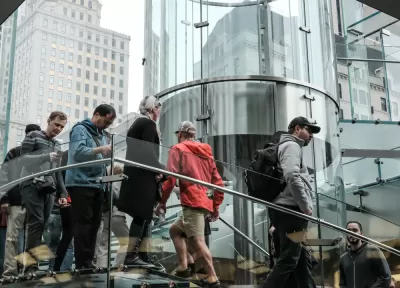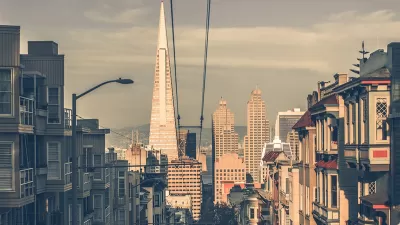Cities around the world are employing vastly different strategies in the effort to get workers back in the office.

Mobility data compiled by Google shows a sharp international divergence in how workers in major financial centers are returning to the office, according to an article by Emily Cadman, Stephan Kahl, Charlotte Ryan, Faris Mokhtar, Nic Querolo, Sarah Holder, Natalie Wong, Steven Arons, Hayley Warren and Sam Dodge. While cities like New York and London have started rebounding, "Singapore and Sydney have had to introduce fresh restrictions as the number of coronavirus cases spikes."
The authors attribute the difference to "vaccination rates and countries’ varying risk appetites." London, New York, and Frankfurt have begun to reopen after vaccines became available, while "cities such as Singapore and Sydney that locked down hard and early—and so got people accustomed to very low levels of infection and risk—have found loosening restrictions tougher as they face further outbreaks."
This hasn't always been the case: by June, Sydney's "[o]ffice occupancy rates had risen to more than 65% of pre-pandemic norms and the state government was poised to launch a voucher program to encourage people back to the city center to eat and drink." But after a massive outbreak of the Delta variant and a months-long lockdown, "the heart of the city is empty." Meanwhile, around 28 percent of the New York region's office workers have returned to work in person and schools fully reopened in September. The article details the trajectory of several other global cities including San Francisco and Frankfurt.
While many cities are experiencing gradual reopenings, "the return to normalcy is still a ways off."
FULL STORY: The March Back to Office Heads in Sharply Different Directions

Trump Administration Could Effectively End Housing Voucher Program
Federal officials are eyeing major cuts to the Section 8 program that helps millions of low-income households pay rent.

Planetizen Federal Action Tracker
A weekly monitor of how Trump’s orders and actions are impacting planners and planning in America.

Ken Jennings Launches Transit Web Series
The Jeopardy champ wants you to ride public transit.

California Invests Additional $5M in Electric School Buses
The state wants to electrify all of its school bus fleets by 2035.

Austin Launches $2M Homelessness Prevention Fund
A new grant program from the city’s Homeless Strategy Office will fund rental assistance and supportive services.

Alabama School Forestry Initiative Brings Trees to Schoolyards
Trees can improve physical and mental health for students and commnity members.
Urban Design for Planners 1: Software Tools
This six-course series explores essential urban design concepts using open source software and equips planners with the tools they need to participate fully in the urban design process.
Planning for Universal Design
Learn the tools for implementing Universal Design in planning regulations.
Ada County Highway District
Clanton & Associates, Inc.
Jessamine County Fiscal Court
Institute for Housing and Urban Development Studies (IHS)
City of Grandview
Harvard GSD Executive Education
Toledo-Lucas County Plan Commissions
Salt Lake City
NYU Wagner Graduate School of Public Service





























